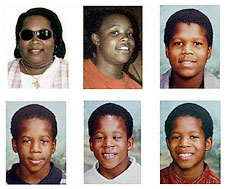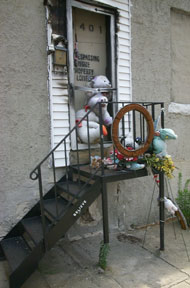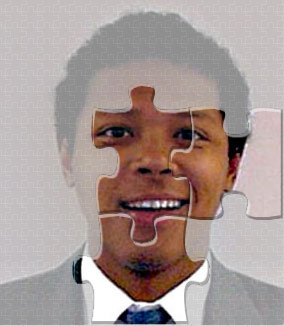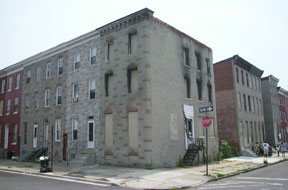Luna concealed Justice Department,
FBI culpability in Dawson family tragedy
Posted December 27, 2004 -- In the months, days, and even
hours before he died, slain Baltimore federal prosecutor Assistant U.S.
Attorney Jonathan Luna actively engaged in concealing FBI and U.S.
Justice Department culpability in what has come to be known in Baltimore
as the Dawson arson fiasco.
Angela and Carnell Dawson, and their five children, were
killed on October 16, 2002, in Baltimore, by a neighborhood heroin dealer
who broke into their home early in the morning and started a gasoline fire
on the stairway of the family's home, killing all inside.
 |
|
|
The Dawson family: (Top left
to bottom right): Angela, Lawanda, Juan, Kevin, Keith and
Carnell Jr. Carnell Sr. is not pictured.
|
The Dawsons for months had been fighting a losing battle
with neighborhood heroin and crack dealers. Many of the drug dealers had prior conviction
records. In the months before they died, the Dawsons called 911 for help
at least thirty-six times, to no avail.
The incident set off national outrage at the non-responsiveness of Baltimore
police. Critics cited a "revolving door" justice system which
allowed the Dawsons' murderer, Darrell Brooks, back on the street
despite numerous arrests and probation violations.
Unfortunately for Luna, on the same day as the Dawsons' murder, October
16, 2002, heroin was found in the SUV of paid FBI informant Warren Grace,
who was working on a case nominally overseen by Luna. It was a stroke of
bad luck for Luna, who had a politician's flair and instincts, superior
to that of his amateurish, publicity hound boss, former Baltimore U.S. Attorney Thomas DiBiagio.
In his new book, The Midnight Ride of Jonathan Luna, Pennsylvania writer
William Keisling details how the heroin incident involving the FBI informant
threw Luna into cover-up mode to protect himself, the FBI and Luna's
boss, (now-former) U.S. Attorney DiBiagio, from the fallout of the "atomic
shock" of the Dawson fiasco.
Following the Dawson murders, hundreds of enraged citizens clamored for
accountability at city meetings and neighborhood rallies across Baltimore.
The brunt of the blame fell on Baltimore Mayor Martin O'Malley and
his then-police commissioner, Ed Norris. "This is our moment of crisis," O'Malley
told the Washington Post, which described the political fallout from the
Dawson fiasco as an "atomic shock."
Luna's boss, U.S. Attorney DiBiagio, assumed federal jurisdiction
of the Dawson-Brooks arson case and cagily positioned himself as a white
knight unconnected to the "revolving door heroin dealer" scandal.
Brooks was sentenced to life behind bars. "He's got another
fifty to sixty years to think about what he did every day he sits in jail," DiBiagio
told the press in 2003. "What a colossal waste. Seven people are
murdered by this drug punk."
"DiBiagio didn't mention the rampaging drug punks
under care of his own office," Keisling writes. "Few people
knew about that. Jonathan Luna was one of the few who did."
In reality, Luna knew, DiBiagio "had a terrible secret of his own," Keisling
reports. "DiBiagio's office gave kid-glove, revolving door
treatment to a heroin dealer every bit as threatening to innocent Baltimoreans
as Darrell Brooks, the murderer of the Dawsons. The dealer's name
was Warren Grace. Grace was not just shooting up his neighborhood, nor
was he merely escaping home confinement. While receiving money from the
FBI, under supervision of Tom DiBiagio's office, Warren Grace was
dealing heroin....
"On the very day the Dawsons died, October 16, 2002, FBI Special
Agent Steve Skinner and his unreachable 'Safe Streets Task Force' sent
Warren Grace into Stash House Records to buy heroin.
"Afterwards, as planned, Warren Grace met the task force at the rendezvous
spot. Grace's vehicle was searched.
"While the Dawsons' house still smoldered, a package of heroin
was found hidden in Grace's Explorer, in a storage compartment.
"Paid FBI informant Warren Grace, on the very day of the Dawsons' mass
murder, was caught with a heroin stash. For months he'd been secretly
marketing heroin on the side, while under FBI employ and supervision.
"Suddenly people were paying attention. Very close attention. Hundreds
of people screamed for official accountability at neighborhood rallies and
town council meetings.
 |
|
"An unsupervised, paid FBI informant caught dealing heroin in the
hood would not have looked very good. In fact, had the truth been made
public in that incendiary moment, U.S. Attorney Tom DiBiagio would certainly
have found himself under attack, if not driven from office. He would have
had his head handed to him in a Fell's Point picnic basket.
"A young assistant U.S. attorney in DiBiagio's office, responsible
for Warren Grace, suddenly found himself sitting on a political scandal
of the first magnitude. He would now have to cover it all up. To protect himself.
To protect his boss. To protect the FBI.
"The young assistant U.S. attorney's name was Jonathan Luna."
Rather than protecting Baltimoreans such as the Dawsons, Keisling relates,
Luna knew that federal law enforcement officials, including the FBI's
aloof "Safe Streets Task Force," were distracted by their own
scandalous and often ridiculous endeavors, which the 515-page book details
at length.
Luna attempted to cover up the Baltimore federal law enforcement scandal
by not properly disclosing information to defense lawyers in the case.
The day of Luna's gruesome murder, a federal judge had ordered an
investigation into the handling of Luna's FBI informant.
The night of his death, Luna repeatedly expressed doubts about the legality
of a plea agreement designed to protect the FBI and the Justice Department
from investigation in the matter. Luna never completed the plea deal before
his death.
Several hours later, Luna's body was found face-down in an icy Pennsylvania
stream, seventy miles from his office. Luna had been stabbed thirty-six
times, once for each time the Dawsons' had unsuccessfully called
911 for help, and once for every thousand dollars missing from a courthouse
safe.
 |
|
In this court transcript, transcribed two days before Luna's brutal murder, defense attorneys complain that Luna is mysteriously withholding information about heroin found on FBI informant Warren Grace on "10-16-02." Unbeknownst to defense lawyers, it's the day the Dawsons' house burned down. To view more Luna transcripts, click here |
An internal affairs investigator interviewed by Keisling for the book
described the number of stab wounds, matching as they do important numbers
in both the Dawson and the missing-money cases, as "crime signatures" that
point to Luna's murder as internal to the Baltimore federal courthouse.
The FBI, meanwhile, continues to suggest that Luna's death was a
suicide, that the athletic thirty-eight-year-old prosecutor stabbed himself
as he supposedly drove alone down the Pennsylvania turnpike, before crawling into
the frigid creek to drown. FBI and the U.S. Department of Justice officials
have also said they are unaware of any motive for Luna's murder.
A spokesperson for Mayor O'Malley declined comment, saying, "I
have no idea what Luna was or wasn't doing," but she acknowedged
the FBI and the Justice Department have a role to play in Baltimore's
streets.
© 2004 by William Keisling

